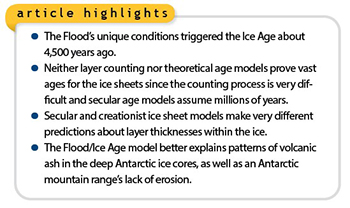 Creationists think the thick ice sheets of Greenland and Antarctica began forming just 4,500 years ago during a short Ice Age triggered by the Genesis Flood. During the Ice Age, warm oceans resulted in tremendous evaporation, causing snowfall rates to be much higher than today. The Flood/Ice Age model easily explains longstanding mysteries of Earth history, such as the ability of millions of woolly mammoths to live in Siberia during the Ice Age.1
Creationists think the thick ice sheets of Greenland and Antarctica began forming just 4,500 years ago during a short Ice Age triggered by the Genesis Flood. During the Ice Age, warm oceans resulted in tremendous evaporation, causing snowfall rates to be much higher than today. The Flood/Ice Age model easily explains longstanding mysteries of Earth history, such as the ability of millions of woolly mammoths to live in Siberia during the Ice Age.1
Counting in Ice Cores
In order to learn about past climates, scientists drill and extract long cores from the ice sheets. Some skeptics see the ice cores, particularly those from Greenland, as very strong arguments for an old earth since scientists have counted more than 100,000 annual layers within them.
However, correctly identifying and counting annual layers are very difficult. In 2018, creation critic Bill Nye inadvertently demonstrated that one cannot naively assume that each visible band within an ice core is an annual layer.2 Annual layers within the ice actually consist of multiple bands of varying thicknesses. Glaciologists must make educated guesses as to which bands should be grouped together and counted as a single year.
In 1978, glaciologists thought that in ice more than 200 years old, annual layers could not be counted with less than 10% error.3 Yet secular scientists now claim less than 10% error for ice that is supposedly tens of thousands of years old. Creationists argue this earlier pessimistic error assessment was more realistic.
Complicating the issue further are stresses within the ice that cause layers to become thinner over time. Moreover, in some places, such as the interior of East Antarctica, annual snowfall is too light for layers to be clearly seen in the ice cores. For this reason, scientists are especially dependent upon theoretical models to find the numbers and present-day thicknesses of annual layers. Their models implicitly assume millions of years, so the vast ages they assign to ice cores are not surprising.4
The Vardiman Model and Its Extension
Creationists are working on ice sheet models that do not make the usual “millions of years” assumption. In 1994, ICR climate expert Dr. Larry Vardiman published an analytical model for the formation of a thick ice sheet in the time since the Genesis Flood.5 He applied this model to a number of ice cores, including the Camp Century core drilled in northwest Greenland in the 1960s. His model was basically the creationist equivalent of a simple uniformitarian ice flow model developed by physicist John Nye that Vardiman applied to the Camp Century ice core.6
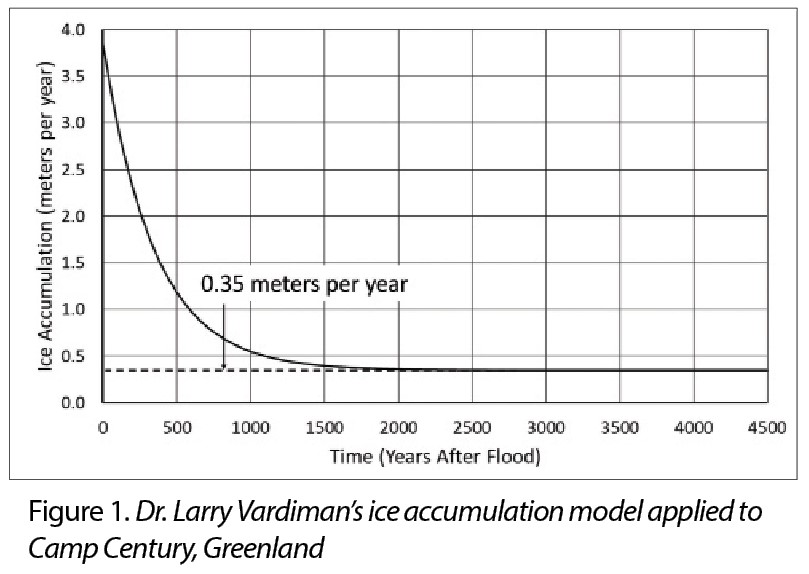
Vardiman assumed the fractional rate of thinning was the same everywhere in the core, was constant in time, and was a very small number.7 He also assumed that ice accumulation rates were high after the Flood and gradually decreased to the lower values we observe today. His model contained adjustable parameters that could be assigned values appropriate to specific ice cores. The Camp Century ice core in 1969 had a depth of 1,370 meters (about 4,500 feet), and the modern-day ice accumulation rate at Camp Century was 35 centimeters, or 0.35 meters, of ice per year.
In my application of Vardiman’s model (Figure 1), accumulation rates start out at 3.85 meters of ice per year right after the Flood and then gradually decrease to the modern rate of 0.35 meters of ice per year. This is in contrast to the secular model, where the accumulation rate has always been roughly what it is today. I wrote a computer code that used Vardiman’s prescribed thinning of the ice to find the final thicknesses of the annual layers.7 The results are compared with results from the Nye model in Figure 2.
Comparing the Results
In both models, annual layer thicknesses are the same in the upper parts of the ice. In Vardiman’s model, layers at the bottom of the ice are about a third of their original thicknesses at the time they were deposited, 1.21 meters thick compared to 3.85 meters. This is in stark contrast to the secular model, which predicts layer thicknesses to become vanishingly small near the base of the ice sheet.
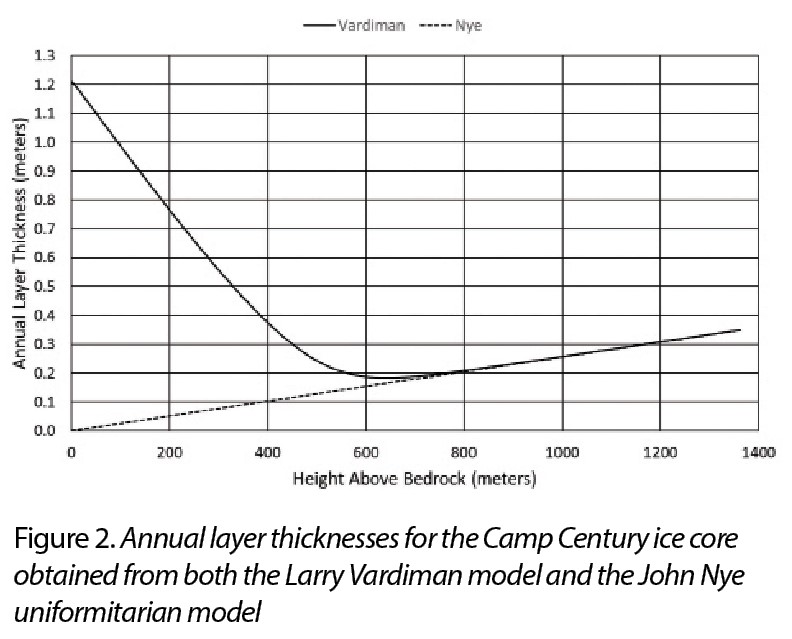 It is noteworthy that in Vardiman’s model the very thinnest layers are not at the very bottom of the ice but at about 650 meters above bedrock. This makes sense because the final thickness of an annual layer depends on both its original thickness when it was deposited and the length of time for which it has been thinning. One might naively guess the very lowest ice layers to be the thinnest since they were deposited first and have been thinning for the longest time.
It is noteworthy that in Vardiman’s model the very thinnest layers are not at the very bottom of the ice but at about 650 meters above bedrock. This makes sense because the final thickness of an annual layer depends on both its original thickness when it was deposited and the length of time for which it has been thinning. One might naively guess the very lowest ice layers to be the thinnest since they were deposited first and have been thinning for the longest time.
On the other hand, you might also guess that the very uppermost layers should be thinnest since these layers are only 35 centimeters thick when first deposited, whereas earlier annual layers started out more than 10 times that thickness (Figure 1). Actually, these two factors balance each other so that the true minimum thickness is found not at the very top or very bottom but about halfway down the core.
As basic as these two models are, they illustrate an important point. Creation-based ice sheet models predict annual layers deep within the ice to be much thicker than do uniformitarian models.
A More Sophisticated Creationist Ice Sheet Model
Vardiman’s model was a good start, but finding the true amount of thinning requires the use of a physics-based computer model that can calculate stresses within the ice. Such models do exist, and they can be stripped of the usual assumptions of millions of years that often bias secular age assignments.8
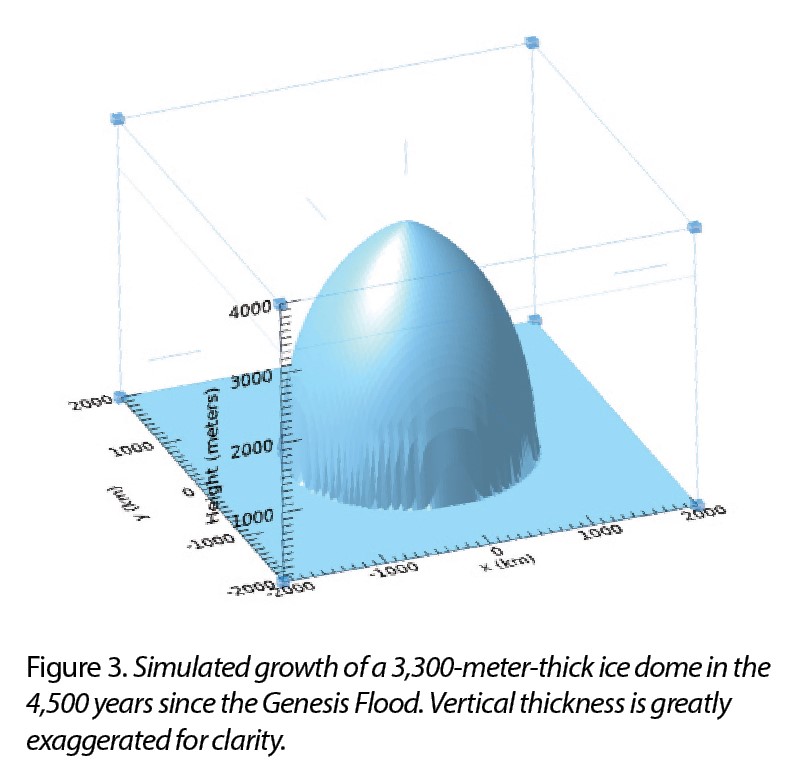 I used a simple version of such a model to run a computer program for 4,500 simulated “years.” This produced the 3,300-meter-tall (10,800 feet) ice dome shown in Figure 3. The paper describing the procedure has been accepted for publication.9 However, this computer model likely overestimates the height of the ice sheet since it ignores, for ease of calculation, some of the stresses within the ice.
I used a simple version of such a model to run a computer program for 4,500 simulated “years.” This produced the 3,300-meter-tall (10,800 feet) ice dome shown in Figure 3. The paper describing the procedure has been accepted for publication.9 However, this computer model likely overestimates the height of the ice sheet since it ignores, for ease of calculation, some of the stresses within the ice.
Also, this particular model doesn’t allow one to find the present-day thicknesses of annual layers within a core. That will require a more sophisticated computer model. However, this model does demonstrate that a thick ice sheet can form quickly if past accumulation rates were much higher than they are now.
Ice Core Tephra Favor the Flood Model
Of course, computer models don’t prove anything since the results depend upon the assumptions that go into the model. However, the Flood/Ice Age model makes better sense of volcanic layers within the ice.
Because explosive volcanic eruptions can deposit layers of volcanic ash and debris (or tephra) onto the ice sheets, tephra layers are sometimes found within the ice cores. Because secular age models greatly underestimate the true thicknesses of the deepest annual layers (Figure 2), those models assign far too much time to a given thickness of ice deep within a core.
In the same way, they assign too much time to the thicknesses of tephra layers deep within the ice. Thus, secular age models can imply that fallout from an explosive volcanic eruption can occur for unreasonably long times. For instance, a simple secular age model implies that one tephra layer in Antarctica’s Dome Fuji core, thought to have originated from a volcano almost 3,000 miles away, was deposited over a period of about five years.10 Has anyone ever observed a single ashfall lasting this long?
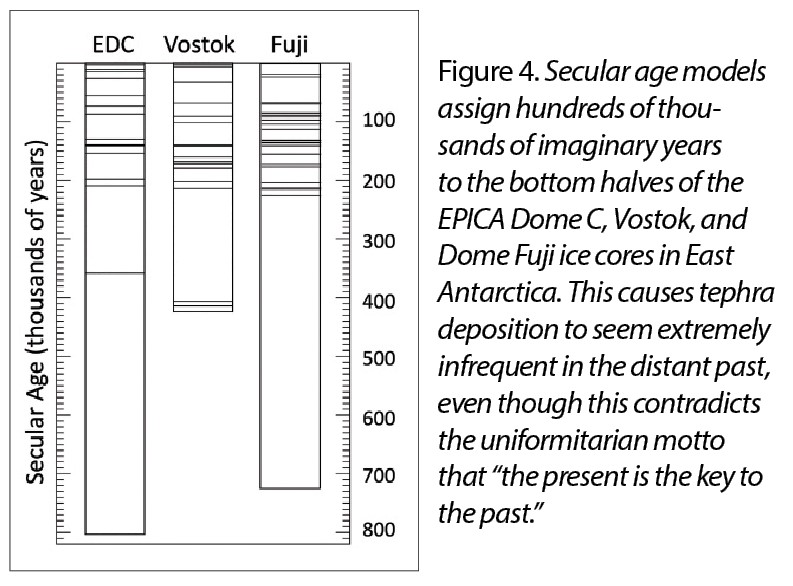 Secular age models also assign truly vast ages to the deep ice cores from East Antarctica. About 85% of this time is assigned to the bottom halves of the cores. If secular models are assigning hundreds of thousands of imaginary “years” to the bottom core sections, tephra deposits deep within these Antarctic cores will consistently seem extremely infrequent when plotted against the secular timescale. This is indeed the case. Three deep ice cores from East Antarctica have been assigned bottom ages greater than 400,000 years, and all three show this pattern (Figure 4).4
Secular age models also assign truly vast ages to the deep ice cores from East Antarctica. About 85% of this time is assigned to the bottom halves of the cores. If secular models are assigning hundreds of thousands of imaginary “years” to the bottom core sections, tephra deposits deep within these Antarctic cores will consistently seem extremely infrequent when plotted against the secular timescale. This is indeed the case. Three deep ice cores from East Antarctica have been assigned bottom ages greater than 400,000 years, and all three show this pattern (Figure 4).4
Scientists plan to drill another deep East Antarctic ice core.11 I predict that if they successfully obtain another undisturbed core, with no folding of the ice that unduly complicates the analysis, the same pattern will show up there as well.
An Astronaut Inside an Egyptian Pyramid?
Both creationists and secularists think most of the world’s major mountain chains formed relatively recently. Creationists think they formed as the Flood was ending and shortly afterward, and secular scientists think they were uplifted just a few million years ago. However, in the secular view the Gamburtsev Mountain range, hidden under the East Antarctic ice sheet, is an exception. Secular scientists have long claimed that the Gamburtsev Mountains are nearly a billion years old. So, uniformitarian scientists were greatly surprised when imaging data revealed that the Gamburtsev Mountains are sharp and craggy, showing little evidence of erosion.4 This lack of erosion is puzzling if the mountain chain is very ancient, but it is easily explained if both the mountain chain and the ice covering it are young.
Evolutionary scientists have proposed two different solutions to this problem, but neither explanation seems to have withstood scrutiny.4 For this reason, some secular scientists are now claiming the Gamburtsev Mountains were formed 50 million years ago.12 This would go a long way in explaining the absence of erosion, but it is a truly radical revision to the secular story!
However, by secular reckoning mechanisms that could have formed the mountains were absent from East Antarctica 50 million years ago. A statement archived on the website of Columbia University’s Lamont-Doherty Earth Observatory illustrates just how badly uniformitarian scientists are bothered by this mountain range. After discussing proposed scenarios for the mountain range’s recent formation, the online article states:
Volcanic? Collisional? Rifting? None of these activities has happened recently in East Antarctica. This region is a very old and stable piece of continental crust. There is no good explanation for how this mountain range exists in a formation that geologists refer to as a Precambrian craton (an old stable piece of the continent that has survived untouched by continental break ups and rearrangements over the last ~500 my). It is like opening the door of an Egyptian pyramid and finding an astronaut inside. There is no good reason for an astronaut to be inside an Egyptian pyramid just as there is no good reason for a major mountain range in the middle of East Antarctica.12
In the absence of a plausible mechanism that could form the mountains recently, uniformitarian thinking seems to demand a vast age for the Gamburtsev Mountains. This leaves the lack of erosion unexplained, but the mystery vanishes if both the Gamburtsev Mountains and the East Antarctic ice sheet are just a few thousand years old.
The Bible’s History Is the Solution
Despite popular hype, deep ice cores do not prove an old earth, and some features within the ice strongly favor the Flood/Ice Age model. The Bible’s short timescale, rather than being a problem for which Christians need to sheepishly apologize, is actually the key to making sense of Earth’s history.
References
- Hebert, J. 2018. The Bible Best Explains the Ice Age. Acts & Facts. 47 (11): 10-13.
- Hebert, J. Bill Nye, PBS Highlight Young-Earth Evidence. Creation Science Update. Posted on ICR.org April 27, 2018, accessed March 11, 2021.
- Hammer, C. U. et al. 1978. Dating of Greenland ice cores by flow models, isotopes, volcanic debris, and continental dust. Journal of Glaciology. 20 (82): 3-26, especially Table 1.
- Hebert, J. 2019. Earth’s Thick Ice Sheets Are Young. Acts & Facts. 48 (2): 11-14.
- Vardiman, L. 1994. An analytic young-Earth flow model of ice sheet formation during the “Ice Age.” In Proceedings of the Third International Conference on Creationism. R. Walsh, ed. Pittsburgh, PA: Creation Science Fellowship, 561-568.
- Dansgaard, W. and S. J. Johnsen. 1969. A Flow Model and a Time Scale for the Ice Core from Camp Century, Greenland. Journal of Glaciology. 8 (53): 215-223, especially 216.
- Hebert, J. 2021. Using Vardiman’s Young-Earth Ice Sheet Model and a Simple Computer Code to Estimate Annual Layer Thicknesses. Creation Research Society Quarterly. 57 (3): 175-184.
- Mahaffy, M. W. 1976. A three-dimensional numerical model of ice sheets: Tests on the Barnes Ice Cap, Northwest Territories. Journal of Geophysical Research. 81 (6): 1059-1066.
- Hebert, J. 2022. Towards a More Realistic Young-Earth Ice Sheet Model: A Shallow, Isothermal Ice Dome with a Frozen Base. Creation Research Society Quarterly. In press.
- Fujii, Y. et al. 1999. Tephra layers in the Dome Fuji (Antarctica) deep ice core. Annals of Glaciology. 29: 126-130.
- Voosen, P. Hunt begins for ancient Antarctic ice—and clues to Earth’s response to rising temperatures. Science News. Posted on science.org October 20, 2021, accessed October 28, 2021.
- The Gamburtsev Mountains. Lamont-Doherty Earth Observatory, Columbia University. Posted on ldeo.columbia.edu, accessed October 28, 2021. Emphasis added.
* Dr. Hebert is Research Scientist at the Institute for Creation Research and earned his Ph.D. in physics from the University of Texas at Dallas.





















